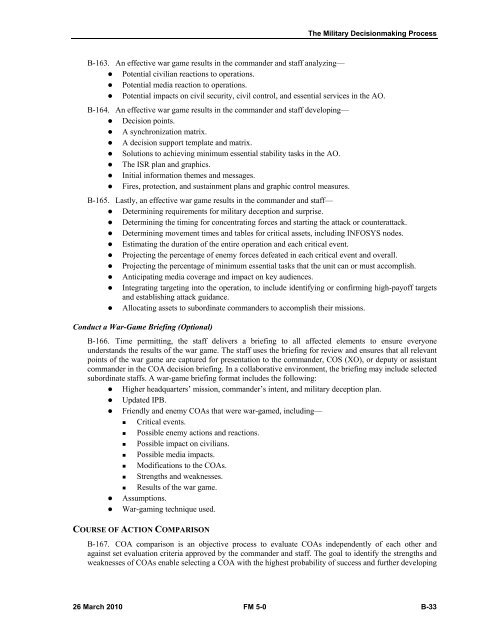FM 5-0, The Operations Process - Federation of American Scientists
FM 5-0, The Operations Process - Federation of American Scientists
FM 5-0, The Operations Process - Federation of American Scientists
You also want an ePaper? Increase the reach of your titles
YUMPU automatically turns print PDFs into web optimized ePapers that Google loves.
<strong>The</strong> Military Decisionmaking <strong>Process</strong><br />
B-163. An effective war game results in the commander and staff analyzing—<br />
• Potential civilian reactions to operations.<br />
• Potential media reaction to operations.<br />
• Potential impacts on civil security, civil control, and essential services in the AO.<br />
B-164. An effective war game results in the commander and staff developing—<br />
• Decision points.<br />
• A synchronization matrix.<br />
• A decision support template and matrix.<br />
• Solutions to achieving minimum essential stability tasks in the AO.<br />
• <strong>The</strong> ISR plan and graphics.<br />
• Initial information themes and messages.<br />
• Fires, protection, and sustainment plans and graphic control measures.<br />
B-165. Lastly, an effective war game results in the commander and staff—<br />
• Determining requirements for military deception and surprise.<br />
• Determining the timing for concentrating forces and starting the attack or counterattack.<br />
• Determining movement times and tables for critical assets, including INFOSYS nodes.<br />
• Estimating the duration <strong>of</strong> the entire operation and each critical event.<br />
• Projecting the percentage <strong>of</strong> enemy forces defeated in each critical event and overall.<br />
• Projecting the percentage <strong>of</strong> minimum essential tasks that the unit can or must accomplish.<br />
• Anticipating media coverage and impact on key audiences.<br />
• Integrating targeting into the operation, to include identifying or confirming high-pay<strong>of</strong>f targets<br />
and establishing attack guidance.<br />
• Allocating assets to subordinate commanders to accomplish their missions.<br />
Conduct a War-Game Briefing (Optional)<br />
B-166. Time permitting, the staff delivers a briefing to all affected elements to ensure everyone<br />
understands the results <strong>of</strong> the war game. <strong>The</strong> staff uses the briefing for review and ensures that all relevant<br />
points <strong>of</strong> the war game are captured for presentation to the commander, COS (XO), or deputy or assistant<br />
commander in the COA decision briefing. In a collaborative environment, the briefing may include selected<br />
subordinate staffs. A war-game briefing format includes the following:<br />
• Higher headquarters’ mission, commander’s intent, and military deception plan.<br />
• Updated IPB.<br />
• Friendly and enemy COAs that were war-gamed, including—<br />
• Critical events.<br />
• Possible enemy actions and reactions.<br />
• Possible impact on civilians.<br />
• Possible media impacts.<br />
• Modifications to the COAs.<br />
• Strengths and weaknesses.<br />
• Results <strong>of</strong> the war game.<br />
• Assumptions.<br />
• War-gaming technique used.<br />
COURSE OF ACTION COMPARISON<br />
B-167. COA comparison is an objective process to evaluate COAs independently <strong>of</strong> each other and<br />
against set evaluation criteria approved by the commander and staff. <strong>The</strong> goal to identify the strengths and<br />
weaknesses <strong>of</strong> COAs enable selecting a COA with the highest probability <strong>of</strong> success and further developing<br />
26 March 2010 <strong>FM</strong> 5-0 B-33















